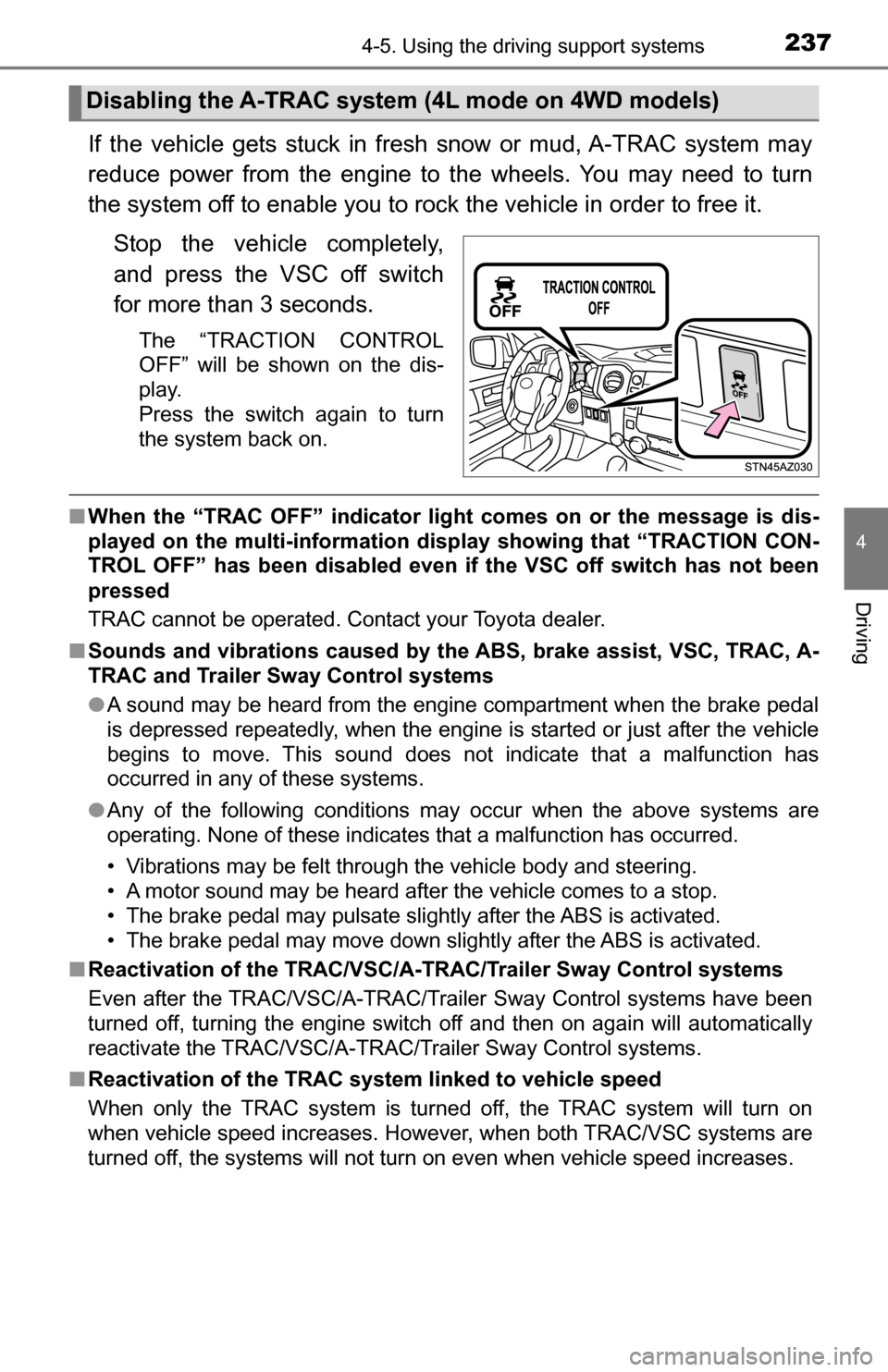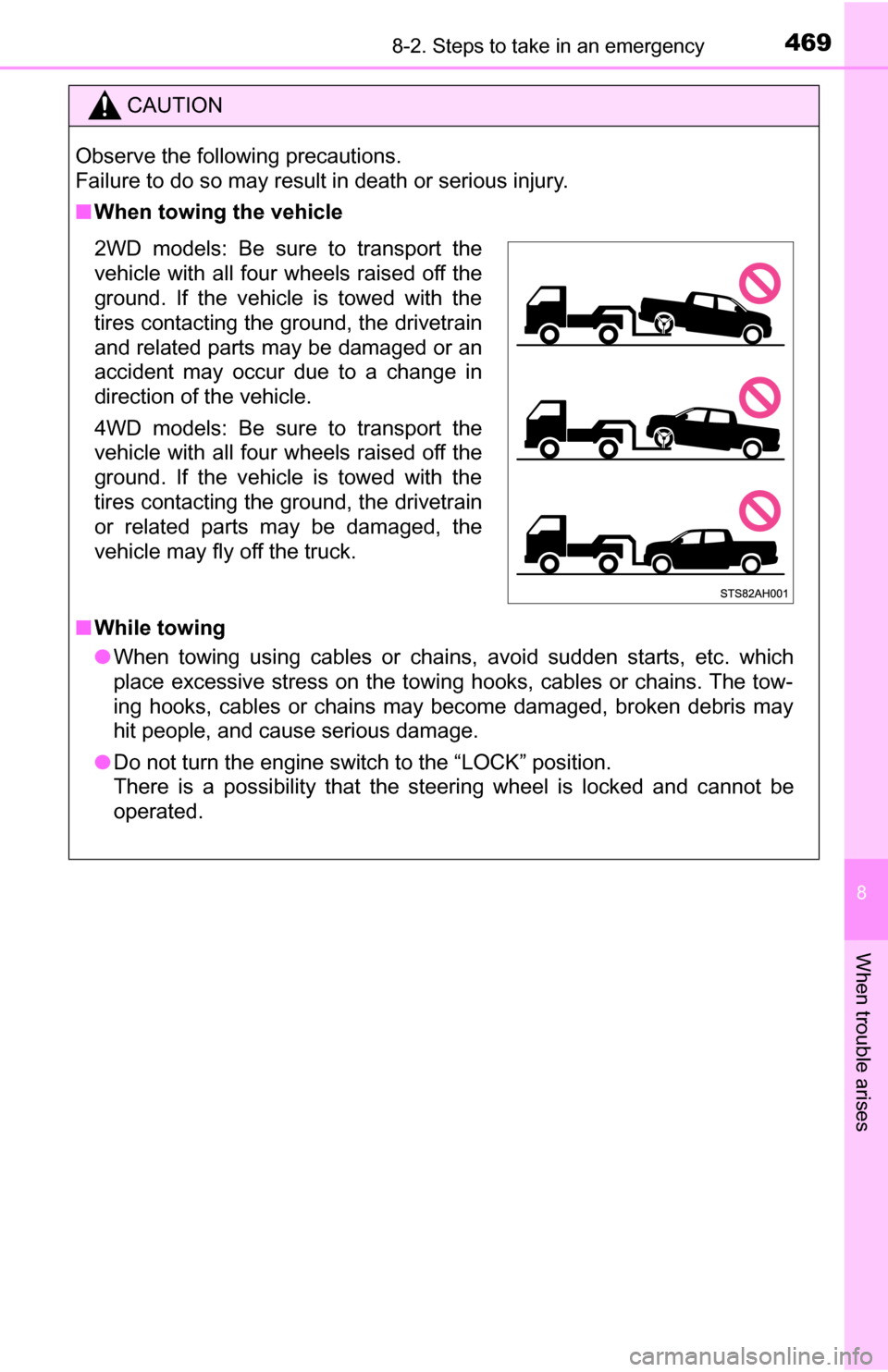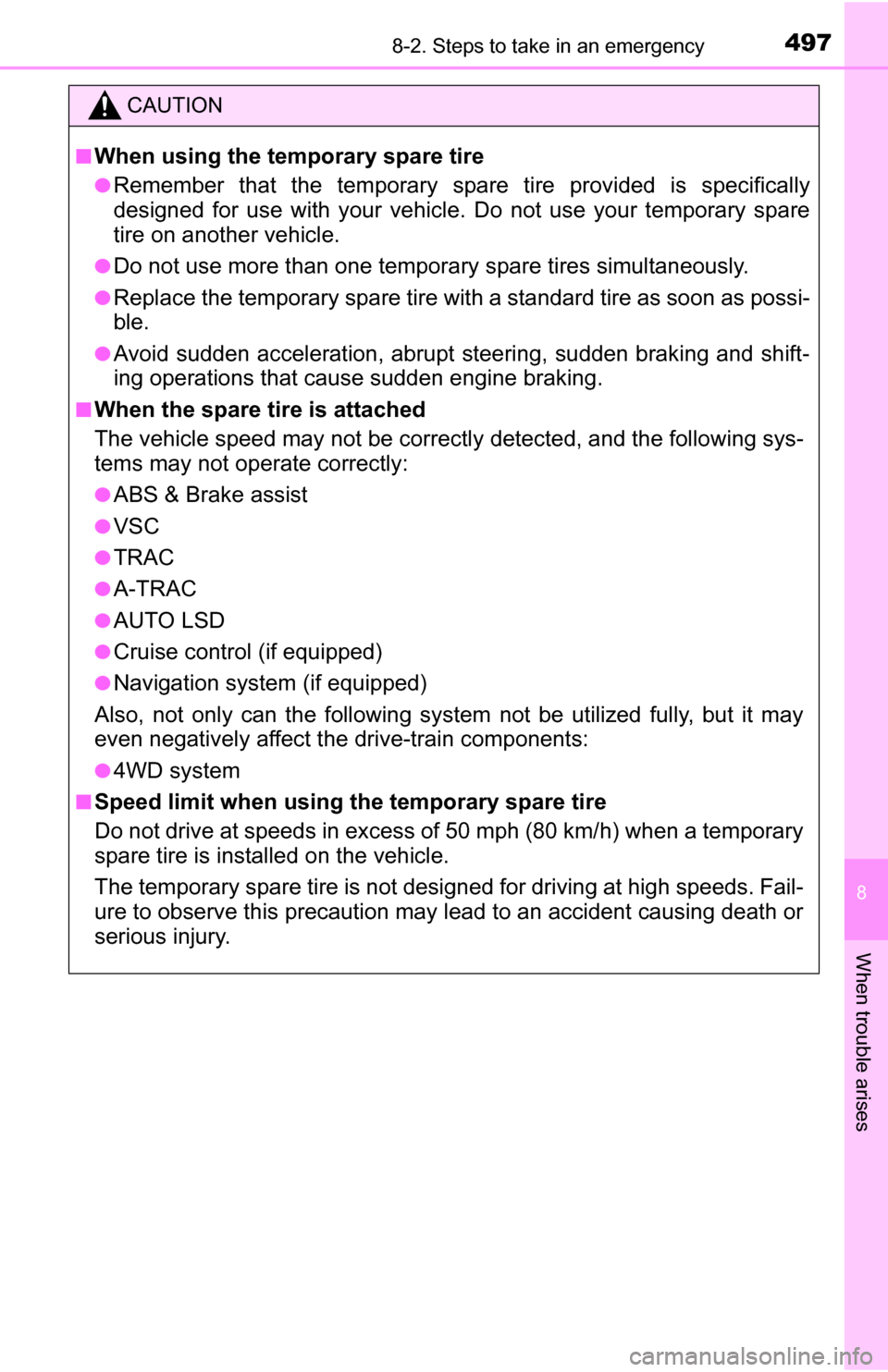Page 237 of 588

2374-5. Using the driving support systems
4
Driving
If the vehicle gets stuck in fresh snow or mud, A-TRAC system may
reduce power from the engine to the wheels. You may need to turn
the system off to enable you to rock the vehicle in order to free it.Stop the vehicle completely,
and press the VSC off switch
for more than 3 seconds.
The “TRACTION CONTROL
OFF” will be shown on the dis-
play.
Press the switch again to turn
the system back on.
■When the “TRAC OFF” indicator light comes on or the message is dis-
played on the multi-information disp lay showing that “TRACTION CON-
TROL OFF” has been disabled even if the VSC off switch has not been
pressed
TRAC cannot be operated. Contact your Toyota dealer.
■ Sounds and vibrations caused by the ABS, brake assist, VSC, TRAC, A-
TRAC and Trailer Sway Control systems
●A sound may be heard from the engine compartment when the brake pedal
is depressed repeatedly, when the engine is started or just after the vehicle
begins to move. This sound does not indicate that a malfunction has
occurred in any of these systems.
● Any of the following conditions may occur when the above systems are
operating. None of these indicates that a malfunction has occurred.
• Vibrations may be felt through the vehicle body and steering.
• A motor sound may be heard after the vehicle comes to a stop.
• The brake pedal may pulsate slightly after the ABS is activated.
• The brake pedal may move down slightly after the ABS is activated.
■ Reactivation of the TRAC/VSC/A-T RAC/Trailer Sway Control systems
Even after the TRAC/VSC/A-TRAC/Trailer Sway Control systems have been
turned off, turning the engine switch off and then on again will automatically
reactivate the TRAC/VSC/A-TRAC/Trailer Sway Control systems.
■ Reactivation of the TRAC system linked to vehicle speed
When only the TRAC system is turned off, the TRAC system will turn on
when vehicle speed increases. However, when both TRAC/VSC systems are
turned off, the systems will not turn on even when vehicle speed increases.
Disabling the A-TRAC system (4L mode on 4WD models)
Page 245 of 588

2454-6. Driving tips
4
Driving
■Tire chain installation
Observe the following precautions when installing and removing chains:
●Install and remove tire chains in a safe location.
● Install tire chains on the rear tires. Do not install tire chains on the front tires.
● Install tire chains on rear tires as tightly as possible. Retighten chains after
driving 1/4 1/2 mile (0.5 1.0 km).
● Install tire chains following the instructions provided with the tire chains.
CAUTION
■ Driving with snow tires
Observe the following precautions to reduce the risk of accidents.
Failure to do so may result in a loss of vehicle control and cause death or
serious injury.
● Use tires of the specified size.
● Maintain the recommended level of air pressure.
● Do not drive in excess of 75 mph (120 km/h), regardless of the type of
snow tires being used.
● Use snow tires on all, not just some wheels.
● 4WD models: Do not mix tires of different makes, models, tread patterns
or treadwear.
■ Driving with tire chains
Observe the following precautions to reduce the risk of accidents.
Failure to do so may result in the vehicle being unable to be driven safely,
and may cause death or serious injury.
● Do not drive in excess of the speed limit specified for the tire chains being
used, or 30 mph (50 km/h), whichever is lower.
● Avoid driving on bumpy road surfaces or over potholes.
● Avoid sudden acceleration, abrupt steering, sudden braking and shifting
operations that cause sudden engine braking.
● Slow down sufficiently before entering a curve to ensure that vehicle con-
trol is maintained.
Page 468 of 588
4688-2. Steps to take in an emergency
If a tow truck is not available in an emergency, your vehicle may be
temporarily towed using cables or chains secured to the emergency
towing hooks. This should only be attempted on hard surfaced roads
for at most 50 miles (80 km) at 18 mph (30km/h).
A driver must be in the vehicle to steer and operate the brakes. The
vehicle’s wheels, drive train, axles, steering and brakes must be in
good condition.
Securely attach cables or chains to the towing hooks.
Take care not to damage the vehicle body.
Enter the vehicle being towed and start the engine.
If the engine does not start, turn the engine switch to the “ON” position.
4WD models: Put the front-wheel drive control switch in “2WD”.
Shift the shift lever to N and release the parking brake.
When the shift lever cannot be shifted: (P. 500)
Emergency towing
Emergency towing procedure
1
Ty p e AType B
2
3
4
Page 469 of 588

4698-2. Steps to take in an emergency
8
When trouble arises
CAUTION
Observe the following precautions.
Failure to do so may result in death or serious injury.
■When towing the vehicle
2WD models: Be sure to transport the
vehicle with all four wheels raised off the
ground. If the vehicle is towed with the
tires contacting the ground, the drivetrain
and related parts may be damaged or an
accident may occur due to a change in
direction of the vehicle.
4WD models: Be sure to transport the
vehicle with all four wheels raised off the
ground. If the vehicle is towed with the
tires contacting the ground, the drivetrain
or related parts may be damaged, the
vehicle may fly off the truck.
■While towing
● When towing using cables or chains, avoid sudden starts, etc. which
place excessive stress on the towing hooks, cables or chains. The tow-
ing hooks, cables or chains may become damaged, broken debris may
hit people, and cause serious damage.
● Do not turn the engine switch to the “LOCK” position.
There is a possibility that the steering wheel is locked and cannot be
operated.
Page 497 of 588

4978-2. Steps to take in an emergency
8
When trouble arises
CAUTION
■When using the temporary spare tire
●Remember that the temporary spare tire provided is specifically
designed for use with your vehicle. Do not use your temporary spare
tire on another vehicle.
●Do not use more than one temporary spare tires simultaneously.
●Replace the temporary spare tire with a standard tire as soon as possi-
ble.
●Avoid sudden acceleration, abrupt steering, sudden braking and shift-
ing operations that cause sudden engine braking.
■When the spare tire is attached
The vehicle speed may not be correctly detected, and the following sys-
tems may not operate correctly:
●ABS & Brake assist
●VSC
●TRAC
●A-TRAC
●AUTO LSD
●Cruise control (if equipped)
●Navigation system (if equipped)
Also, not only can the following system not be utilized fully, but it may
even negatively affect the drive-train components:
●4WD system
■Speed limit when using the temporary spare tire
Do not drive at speeds in excess of 50 mph (80 km/h) when a temporary
spare tire is installed on the vehicle.
The temporary spare tire is not designed for driving at high speeds. Fail-
ure to observe this precaution may lead to an accident causing death or
serious injury.
Page 511 of 588
5119-1. Specifications
9
Vehicle specifications
4WD models
*1: Unladen vehicle
*2: P255/70R18 tires
*3: P275/65R18 tires
*4: P275/55R20 tires
Cab type Regular Cab Double CabCrewMax
Bed type Long Standard Long Short
Overall
length228.9 in. (5815 mm) 247.8 in.
(6295 mm) 228.9 in.
(5815 mm)
Overall
width 79.9 in. (2030 mm)
Overall
height
*1
76.1 in.
(1935 mm)
*276.3 in.
(1940 mm)
*276.1 in.
(1935 mm)
*2
75.9 in.
(1930 mm)
*376.1 in.
(1935 mm)
*3,*475.9 in.
(1930 mm)
*3,*4
Wheelbase 145.6 in. (3700 mm) 164.5 in.
(4180 mm) 145.6 in.
(3700 mm)
Front tread 67.9 in. (1725 mm)
Rear tread 67.9 in. (1725 mm)
Page 512 of 588
5129-1. Specifications
Regular Cab models
*1: The model code is indicated on the Certification Label. (P. 519)
*2: Vehicles with towing package
*3: Vehicles with towing package and large fuel tank
*4: Vehicles without option
Vehicle capacity weight
Model code*1EngineDriving
systemBed type
Vehicle capacity weight
(Occupants + luggage)
USK51L-THTSKA 3UR-FE
engine
2WD
Long
1965 lb. (890 kg)
1890 lb. (855 kg)*2
1770 lb. (800 kg)*3
2035 lb. (920 kg)*4
USK51L-THTSGA 3UR-FBE
engine
1965 lb. (890 kg)
1890 lb. (855 kg)*2
1770 lb. (800 kg)*3
2035 lb. (920 kg)*4
USK56L-THTSKA 3UR-FE
engine
4WD
1905 lb. (860 kg)
1830 lb. (830 kg)*2
1710 lb. (775 kg)*3
USK56L-THTSGA 3UR-FBE
engine
1905 lb. (860 kg)
1830 lb. (830 kg)*2
1710 lb. (775 kg)*3
Page 513 of 588
5139-1. Specifications
9
Vehicle specifications
Double Cab models
Model code*1EngineDriving
systemBed type
Vehicle capacity weight
(Occupants + luggage)
UPK51L-CRTSKA 1UR-FE
engine 2WD
Standard
1405 lb. (635 kg)
UPK56L-CRTSKA 4WD
1315 lb. (595 kg)
USK51L-CRTSKA 3UR-FE engine
2WD
1590 lb. (720 kg)
1515 lb. (685 kg)*2
1390 lb. (630 kg)*3
USK51L-CRTLKA
1560 lb. (705 kg)
1485 lb. (670 kg)*2
1365 lb. (615 kg)*3
USK51L-CRTSGA 3UR-FBE engine
1590 lb. (720 kg)
1515 lb. (685 kg)*2
1390 lb. (630 kg)*3
USK51L-CRTLGA
1560 lb. (705 kg)
1485 lb. (670 kg)*2
1365 lb. (615 kg)*3
USK52L-CHTSKA 3UR-FE
engine
Long
1560 lb. (705 kg)
1485 lb. (670 kg)*2
1365 lb. (615 kg)*3
USK52L-CHTSGA3UR-FBE
engine
1560 lb. (705 kg)
1485 lb. (670 kg)*2
1365 lb. (615 kg)*3
USK56L-CRTSKA
3UR-FE engine 4WD Standard
1495 lb. (675 kg)
1425 lb. (645 kg)*2
1300 lb. (585 kg)*3
USK56L-CRTLKA
1490 lb. (675 kg)
1415 lb. (640 kg)*2
1295 lb. (585 kg)*3